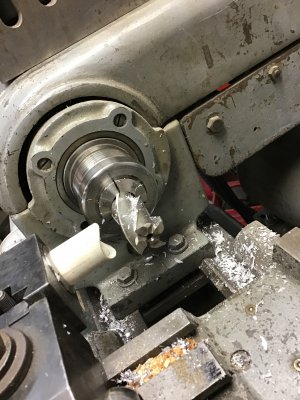- Joined
- Feb 28, 2019
- Messages
- 503
Thanks everyone for the ideas - and making me think about it more thoroughly.
I did say the major/largest diameter is 1", along with the total length of the standoff - thought that would be enough for these purposes.
Tolerances are not very tight - all that really matters is the standoff height and that the flat and saddle are square to the axis. I bolt slides loosely through the center hole.
Material is phenolic or something like that. Not high temp or any other requirements just needs to be strong "enough" ( FYI - standoffs support the large rubber ball S tracks in a bowling ball lifter! )
This discussion has made me realize that there really isn't a way to save time by pre-drilling the saddles. The diameter of the saddle hole is .875 - there would be very little left holding a 1" rod together after drilling.
I don't have an end mill that big (or a drill for that matter!). I don't think I would have much use for something that size on my benchtop drill mill - just not rigid enough! However, will probably be fine with a slightly softer material. Any of my attempts to plough a 1/2" mill into the side of a chunk of metal have been less than satisfactory so far, other than pretty small depths of cut.
So it seams like the best approach (for me) will be to by some appropriate 1" rod stock, bandsaw off 48 short lengths, then use my 3 jaw, face an end, use a chuck stop insert thing when I flip them around, turn the tee / smaller diameters and then go to the mill to do the saddles.
Any thoughts on a material to use? I did a quick look on MSC for phenolic and found "Easy-to-machine Garolite rods" stuff is pretty pricey.
There is probably a cheaper plastic that would work (does need to hold up in outdoors/sunlight). I don't really know my materials that well.
-Dave
I did say the major/largest diameter is 1", along with the total length of the standoff - thought that would be enough for these purposes.
Tolerances are not very tight - all that really matters is the standoff height and that the flat and saddle are square to the axis. I bolt slides loosely through the center hole.
Material is phenolic or something like that. Not high temp or any other requirements just needs to be strong "enough" ( FYI - standoffs support the large rubber ball S tracks in a bowling ball lifter! )
This discussion has made me realize that there really isn't a way to save time by pre-drilling the saddles. The diameter of the saddle hole is .875 - there would be very little left holding a 1" rod together after drilling.
I don't have an end mill that big (or a drill for that matter!). I don't think I would have much use for something that size on my benchtop drill mill - just not rigid enough! However, will probably be fine with a slightly softer material. Any of my attempts to plough a 1/2" mill into the side of a chunk of metal have been less than satisfactory so far, other than pretty small depths of cut.
So it seams like the best approach (for me) will be to by some appropriate 1" rod stock, bandsaw off 48 short lengths, then use my 3 jaw, face an end, use a chuck stop insert thing when I flip them around, turn the tee / smaller diameters and then go to the mill to do the saddles.
Any thoughts on a material to use? I did a quick look on MSC for phenolic and found "Easy-to-machine Garolite rods" stuff is pretty pricey.
There is probably a cheaper plastic that would work (does need to hold up in outdoors/sunlight). I don't really know my materials that well.
-Dave


